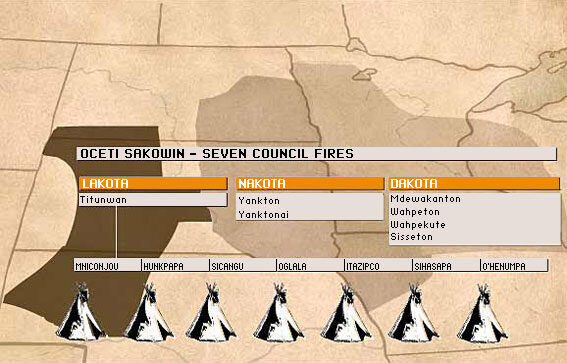Dakota (Oceti Šakowiŋ)
The term “Sioux” has its origins in the the neighboring language of the Ojibwe (Anishinaabe) people and was a mispronunciation by European immigrants. Various interpretations explain that it may refer to "people of the river that snakes," or may be derived from a phrase that means "those that speak another language." Today, many people reject the term as being negative, while others, especially tribal governments, use it self-referentially and embrace it officially.
Historically, there were seven major divisions — "council fires" — of the Dakota, each with a distinct but similar culture. Mdewakaŋtoŋwaŋ, The Spirit Lake People (Mdewakanton); Waĥpekute, The Shooters Among the Leaves People (Wahpekute); Waĥpetoŋwaŋ, The People Dwelling Among the Leaves (Wahpeton); and Sisitoŋwaŋ, People of the Fish Village(s) (Sisseton), are referred to as the Santee or Eastern Dakota. Ihaŋktoŋwaŋ, Dwellers at the End (Yankton); and Ihaŋktoŋwaŋna, Little Dwellers at the End (Yanktonai), are referred to as the Western Dakota or often as the Nakota; and the Ti´toŋwaŋ, Dwellers on the Plains (Teton) are called Lakota. The historic alliance of these divisions has been known variously over time as the Sioux, the Great Sioux Nation, or Oceti Ŝakowiŋ, the Seven Council Fires. Today Dakota, Lakota, and Nakota tribal governments and communities are located in Minnesota, North and South Dakota, Nebraska, and Montana in the United States, and Alberta, Manitoba and Saskatchewan in Canada.
From Oceti Šakowiŋ: The Seven Council Fires. MNHS Collections.
| Title | Other Details |
|---|
Other Communities
Permissions beyond the scope of this license may be available at Copyright and Use Information.













